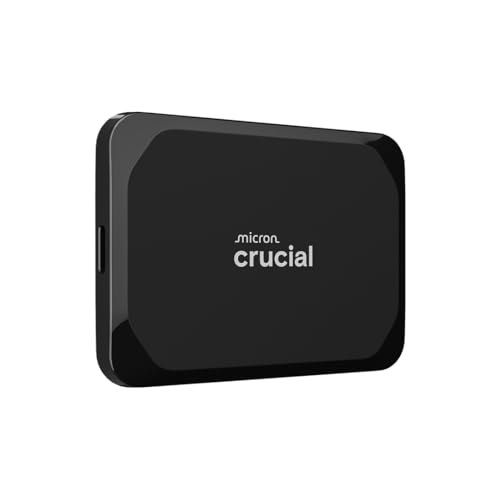Video editing can be a challenging beast for any computer. You’re dealing with massive files, demanding software, and real-time playback that can stutter, lag, and generally slow you down if your hardware isn’t up to snuff. While many components play a role, your storage drive is arguably one of the most critical. That’s where a high-performance SSD comes into play, transforming your workflow from frustrating to fantastic.
When it comes to reliable and speedy storage, Crucial has carved out a solid reputation. They offer a range of SSDs that are perfect for tackling the rigors of video editing. But with so many options, how do you pick the Crucial best SSD drive for video editing for your specific needs? Don’t sweat it! We’ve done the heavy lifting and compiled a list of the top Crucial SSDs that will make your editing experience smoother, faster, and much more enjoyable.
Why SSDs Are a Game-Changer for Video Editing
Traditional hard disk drives (HDDs) just can’t keep up with the demands of modern video editing. HDDs use spinning platters, which are inherently slower for reading and writing large video files, especially 4K, 6K, or 8K footage. This often leads to frustrating render times, choppy playback, and slow project loading.
Solid State Drives (SSDs), on the other hand, use flash memory, offering significantly faster data transfer speeds. This means:
- Faster Project Loading: Open your editing software and projects in a flash.
- Smoother Playback: Say goodbye to dropped frames and stuttering.
- Quicker Renders & Exports: Finish your projects faster, freeing up time for more creative work.
- Improved Multitasking: Run multiple applications without your system grinding to a halt.
- Enhanced Reliability: No moving parts mean less risk of mechanical failure.
What to Look for in a Video Editing SSD
Before we dive into the products, here’s a quick rundown of what to consider:
- Speed: Look for sequential read/write speeds. For portable drives, 1000MB/s is good, 2000MB/s+ is excellent. For internal NVMe drives, aim for 5000MB/s+ (Gen4) or even 10,000MB/s+ (Gen5) for professional work.
- Capacity: Video files eat up space quickly. Don’t underestimate your needs. 1TB is a starting point, but 2TB, 4TB, or even 8TB is often necessary for larger projects or multiple ongoing tasks.
- Form Factor: Do you need an internal drive (NVMe M.2 for workstations) or a portable external drive (USB-C) for on-the-go editing?
- Durability (for portable drives): If you’re often editing in the field, look for water, dust, and drop resistance.
- Compatibility: Ensure the drive works with your operating system and devices (Windows, Mac, iPad Pro, etc.).
Now, let’s explore the top Crucial SSDs that are perfect for video editors!
1. Crucial X9 2TB Portable SSD, Up to 1050MB/s, USB 3.2
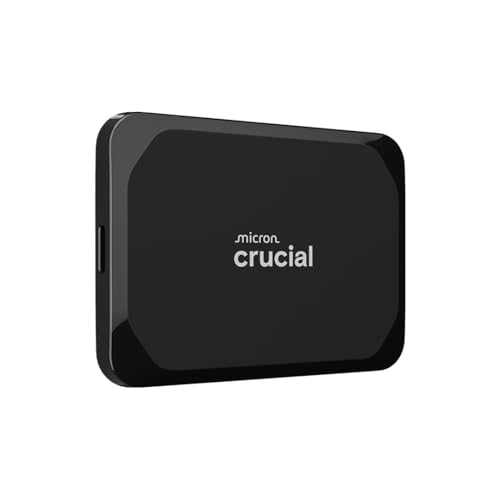
The Crucial X9 2TB Portable SSD hits a sweet spot for many video editors who need reliable, fast external storage without breaking the bank. Its 2TB capacity offers plenty of room for current projects and essential media, while its 1050MB/s speeds significantly outperform traditional hard drives, making it a solid choice for accelerating large file transfers and media editing on the go. Whether you’re a student, a casual content creator, or someone needing a robust backup solution, the X9’s durable design and broad compatibility make it an excellent companion for any workflow.
Key Features:
– High-speed Performance: Up to 1050MB/s sequential read/write speeds.
– Built to Last: IP55 water and dust resistance, drop resistant up to 7.5 ft (2 meters).
– Broad Compatibility: Works with Windows, Mac, iPad Pro, Chromebooks, Android, Linux, PS4, PS5, Xbox via USB-C and USB-A.
– High-Capacity Storage: 2TB capacity for photos, videos, backups, and more.
– Bonus Software: Includes three months of Mylio Photos+ and Acronis True Image.
Pros:
– Excellent balance of speed and affordability for portable storage.
– Very durable and rugged, ideal for field use.
– Wide compatibility across many devices.
– Compact and lightweight design.
Cons:
– Not the absolute fastest portable SSD available (compared to X10 models).
– USB 3.2 Gen2 interface might be a bottleneck for some professional users.
User Impressions:
Users consistently praise the Crucial X9 2TB for its reliable performance and robust build quality. Many highlight its ease of use with various devices, including editing laptops and gaming consoles. It’s frequently recommended for those needing a fast, dependable external drive for media management and project backups without venturing into the ultra-premium price range.
2. Crucial X10 8TB Portable SSD, Up to 2,100MB/s, USB 3.2
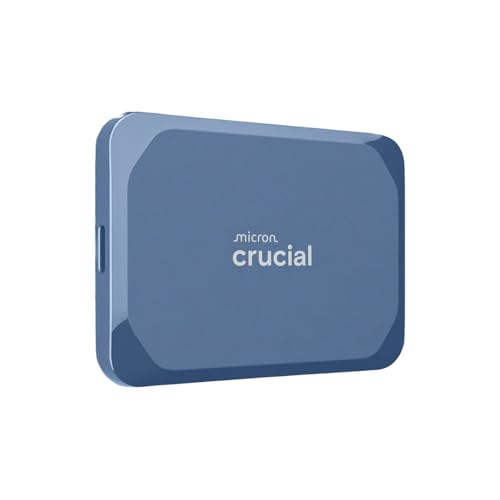
For serious content creators drowning in 4K or 8K footage, the Crucial X10 8TB Portable SSD is a dream come true. This drive isn’t just about massive storage; it brings ultra-fast 2,100MB/s read speeds, effectively cutting down waiting times for large project files and media assets. Its colossal 8TB capacity means you can keep multiple high-resolution projects, extensive media libraries, and critical backups all in one place, while its enhanced durability ensures your valuable data is safe, no matter where your creative journey takes you. This is truly a Crucial best SSD drive for video editing when you need both speed and immense storage on the go.
Key Features:
– Ultra-fast Speeds: Up to 2,100MB/s sequential read speeds.
– Built to Last: IP65 dust and water resistance, drop resistant up to 9.8 ft (3 meters).
– Broad Compatibility: Connects with Windows, Mac, iPad Pro, Chromebooks, Android, Linux, PS4, PS5, Xbox via USB-C and USB-A.
– Ultimate Storage Capacity: Massive 8TB capacity for all your high-res media and projects.
– Bonus Software: Includes three months of Mylio Photos+ and Acronis True Image.
Pros:
– Incredible 8TB capacity, perfect for extensive video libraries.
– Blazing fast speeds significantly boost workflow efficiency.
– Superior IP65 durability for peace of mind in challenging environments.
– Excellent for professional creators and large-scale projects.
Cons:
– Premium price point due to capacity and speed.
– USB 3.2 Gen2x2 host port required to achieve maximum speeds, which not all devices have.
User Impressions:
Professional video editors and photographers rave about the X10 8TB’s sheer speed and storage capabilities. Many report a noticeable improvement in project loading and rendering times, especially when working with high-resolution footage. The ruggedness is also a major plus for those who travel for shoots, making it a top choice for mobile creative workflows.
3. Crucial X9 1TB Portable SSD, Up to 1050MB/s, USB 3.2

If you’re looking for an entry-level yet highly capable external SSD for video editing, the Crucial X9 1TB Portable SSD is an excellent starting point. Offering the same robust 1050MB/s transfer speeds as its larger 2TB sibling, this 1TB version provides a perfect balance of performance and affordability for those with more modest storage needs or for segmenting projects. It’s ideal for students, budding content creators, or anyone who wants to experience the benefits of SSD speed for their smaller video projects, media backups, and general file transfers without investing in higher capacities immediately.
Key Features:
– High-speed Performance: Up to 1050MB/s sequential read/write speeds.
– Built to Last: IP55 water and dust resistance, drop resistant up to 7.5 ft (2 meters).
– Broad Compatibility: Works with Windows, Mac, iPad Pro, Chromebooks, Android, Linux, PS4, PS5, Xbox via USB-C and USB-A.
– High-Capacity Storage: 1TB capacity for photos, videos, backups, and more.
– Bonus Software: Includes three months of Mylio Photos+ and Acronis True Image.
Pros:
– Very affordable entry into high-speed portable SSD storage.
– Durable and travel-friendly design.
– Great for smaller projects, active working files, or as a boot drive for editing.
– Wide device compatibility.
Cons:
– 1TB might be limiting for large, multiple 4K video projects.
– Not as fast as the X10 series for professional, high-demand workflows.
User Impressions:
Customers appreciate the X9 1TB for its solid performance, especially given its price point. It’s often highlighted as a reliable and durable option for everyday tasks, light video editing, and secure backups. Users find it significantly faster than external HDDs and perfect for extending laptop storage on the go.
4. Crucial X10 4TB Portable SSD, Up to 2,100MB/s, USB 3.2
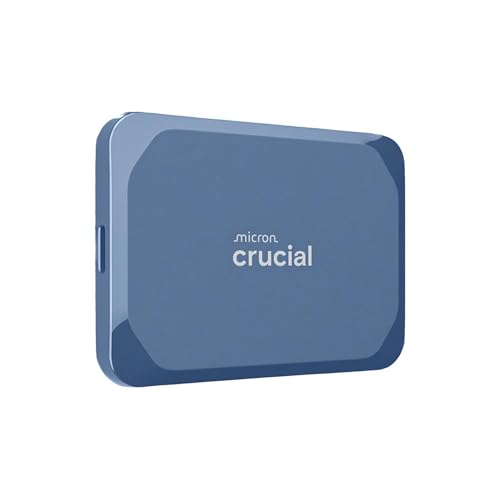
The Crucial X10 4TB Portable SSD offers an exceptional blend of speed and generous storage, making it a powerhouse for professional and enthusiast video editors alike. With blazing-fast read speeds of up to 2,100MB/s, you’ll experience dramatically reduced load times for large video assets and projects, ensuring a fluid editing experience. The 4TB capacity strikes a fantastic balance, providing ample space for numerous 4K video projects and extensive media libraries, while still being more accessible than the 8TB model. Its robust build quality also means it’s ready for the demands of fieldwork.
Key Features:
– Ultra-fast Speeds: Up to 2,100MB/s sequential read speeds.
– Built to Last: IP65 dust and water resistance, drop resistant up to 9.8 ft (3 metres).
– Broad Compatibility: Connects effortlessly with Windows, Mac, iPad Pro, Chromebooks, Android, Linux, PS4, PS5, Xbox via USB-C and USB-A.
– Ultimate Storage Capacity: 4TB capacity for all your high-res media and projects.
– Bonus Software: Includes three months of Mylio Photos+ and Acronis True Image.
Pros:
– Excellent combination of high speed and substantial storage capacity.
– Superior durability (IP65) for robust field performance.
– Significantly improves video editing workflow speed.
– Great value for a high-performance 4TB portable SSD.
Cons:
– Requires a USB 3.2 Gen2x2 port on your host device to reach maximum advertised speeds.
– Still a considerable investment, though less than the 8TB variant.
User Impressions:
Editors working with large video files consistently praise the X10 4TB for its performance boost and storage convenience. Many remark on how quickly files transfer and projects load. The durable casing and compact size are also frequently cited as reasons why it’s a go-to choice for managing crucial video assets, whether in the studio or out in the field.
5. Crucial T700 4TB Gen5 NVMe M.2 SSD – Up to 12,400MB/s

When it comes to the absolute pinnacle of internal storage for a dedicated video editing workstation, the Crucial T700 4TB Gen5 NVMe M.2 SSD stands in a league of its own. This isn’t just fast; it’s blisteringly fast, with sequential reads up to 12,400MB/s and writes up to 11,800MB/s. For professional video editors dealing with multi-stream 8K footage, complex visual effects, and demanding rendering tasks, this drive is a game-changer. It leverages the latest Gen5 technology to drastically reduce load times, accelerate texture renders, and minimize CPU utilization, ensuring your system runs at peak performance. This is undoubtedly the Crucial best SSD drive for video editing if you’re building a high-end desktop.
Key Features:
– BLISTERING SPEEDS: Up to 12,400/11,800MB/s sequential reads/writes.
– ULTIMATE GAMING & CREATIVITY: Elevates gaming with faster texture renders and reduced load times; renders UHD/8K+ videos with up to 99% less CPU utilization.
– COMPATIBLE: Installs easily in M.2 slot, requires a motherboard heatsink and appropriate airflow.
– INNOVATION: Micron 232-layer TLC NAND for Intel 13th Gen and AMD Ryzen 7000 CPUs.
– SPACIOUS: 4TB capacity for massive projects, media, and applications.
Pros:
– Unrivaled speed for internal storage, dramatically improving workflow.
– Ideal for high-resolution (8K+) video editing and heavy workloads.
– Reduces CPU strain, allowing for more efficient multitasking.
– Large 4TB capacity for extensive project files.
Cons:
– Requires a Gen5 compatible motherboard and a dedicated heatsink (sometimes sold separately) for optimal performance.
– Higher price point than Gen4 NVMe drives.
– Not a portable solution.
User Impressions:
Early adopters and high-end workstation builders are astonished by the T700’s performance. They report instantaneous project loading, seamless scrubbing through dense timelines, and rendering times cut significantly. It’s considered an essential upgrade for anyone pushing the boundaries of professional video production and requiring the fastest internal storage available.
6. Crucial X10 Pro 2TB Portable SSD, Up to 2100MB/s Read, 2000MB/s Write
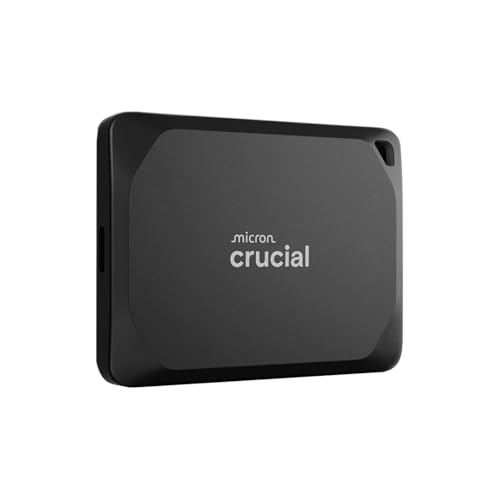
The Crucial X10 Pro 2TB Portable SSD is engineered specifically for professional creators who demand top-tier performance and robust reliability in a portable package. Building on the strengths of the X10, the Pro version offers exceptional read speeds of 2,100MB/s and equally impressive write speeds of 2,000MB/s, ensuring a truly seamless workflow for 4K and even 8K video editing on location. Its enhanced IP55 durability, combined with features like a lanyard loop, activity light, and SSD password protection, makes it an ideal, secure, and highly efficient external storage solution for fieldwork and critical data.
Key Features:
– Ultra-fast Speeds: Up to 2,100MB/s read and 2,000MB/s write speeds.
– Built to Last: IP55 water and dust resistance, drop resistant up to 7.5 ft (2 meters), includes lanyard loop, activity light, and SSD password protection.
– Broad Compatibility: Connects effortlessly with Windows, Mac, iPad Pro, Chromebooks, Android, Linux, PS4, PS5, Xbox via USB-C and USB-A.
– Massive Storage Capacity: 2TB capacity for high-resolution photos, 4K/8K videos, and current projects.
– Bonus Software: Includes three months of Mylio Photos+ and Acronis True Image.
Pros:
– Excellent symmetrical read/write speeds for professional workflow.
– Enhanced durability and security features (password protection, lanyard loop).
– Ideal for demanding field productions and high-res media.
– Compact and truly portable design.
Cons:
– Maximum speeds require a USB 3.2 Gen2x2 host port.
– Price point is higher than standard portable SSDs.
User Impressions:
Professional videographers and content creators frequently highlight the X10 Pro’s exceptional speed and robust build. The added security features like password protection and the convenient lanyard loop are much appreciated for on-the-go work. It’s seen as a reliable workhorse for backing up and actively editing high-res footage directly from the drive, even in less-than-ideal conditions.
7. Crucial X9 Pro 1TB Portable SSD, Up to 1050MB/s Read, 1050MB/s Write

The Crucial X9 Pro 1TB Portable SSD offers professional creators a reliable and secure portable drive at a slightly more accessible capacity. Delivering solid 1050MB/s read and write speeds, it’s perfect for managing active video projects, transferring large media files, and ensuring smooth playback for demanding tasks, all while on the move. Like its X10 Pro sibling, it boasts IP55 water and dust resistance, along with essential security features like password protection and a handy lanyard loop, making it a dependable choice for fieldwork where data integrity and portability are paramount.
Key Features:
– High-speed Performance: Up to 1050MB/s read and 1050MB/s write speeds.
– Built to Last: IP55 water and dust resistance, drop resistant up to 7.5 ft (2 meters), includes lanyard loop, activity light, and SSD password protection.
– Broad Compatibility: Connects effortlessly with Windows, Mac, iPad Pro, Chromebooks, Android, Linux, PS4, PS5, Xbox via USB-C and USB-A.
– Secure Storage: 1TB capacity for high-resolution photos, videos, and active projects with added security features.
– Bonus Software: Includes three months of Mylio Photos+ and Acronis True Image.
Pros:
– Professional-grade performance and durability at 1TB capacity.
– Symmetrical read/write speeds are great for demanding workflows.
– Enhanced security features and robust build for peace of mind.
– More affordable Pro option for users needing reliable portable storage.
Cons:
– 1TB might be too small for very large 4K/8K projects or extensive media libraries.
– Speeds are good, but not as blazing as the X10 Pro series.
User Impressions:
Users value the X9 Pro 1TB for its blend of professional features, durability, and consistent performance. Many find it an ideal drive for carrying current project files, daily backups, or even as a scratch disk for their editing software when working remotely. The added security aspects are a definite bonus for protecting sensitive client work.
Final Thoughts
Choosing the Crucial best SSD drive for video editing ultimately depends on your specific workflow, budget, and whether you need internal power or portable flexibility. For desktop workstations, the Crucial T700 Gen5 NVMe is an absolute beast for unmatched internal speed. For external, portable powerhouses, the X10 and X10 Pro series offer incredible data transfer speeds and robust durability, especially in 4TB and 8TB capacities. If you’re starting out or need a solid, reliable portable drive for less demanding tasks, the X9 and X9 Pro series provide excellent value.
No matter which Crucial SSD you choose, you’ll be giving your video editing setup a significant boost, allowing you to spend less time waiting and more time creating. Happy editing!
FAQ Section
Q1: Why is an SSD better than an HDD for video editing?
A1: SSDs use flash memory, which allows for significantly faster read and write speeds compared to traditional HDDs with spinning platters. This results in quicker project loading, smoother playback of high-resolution footage (like 4K or 8K), faster rendering and export times, and overall improved workflow efficiency, making them crucial for video editing performance.
Q2: What’s the difference between a portable SSD and an internal NVMe SSD?
A2: A portable SSD (like the Crucial X-series) connects externally, usually via USB-C, offering convenience and portability. An internal NVMe SSD (like the Crucial T700) plugs directly into your computer’s motherboard (M.2 slot), providing the fastest possible data transfer speeds within a desktop workstation. Portable drives are great for on-the-go editing, while internal NVMe drives are best for dedicated editing rigs.
Q3: How much capacity do I need for video editing?
A3: Video files are large! For casual editing, 1TB might suffice for active projects. However, for 4K or 8K footage, multiple projects, or extensive media libraries, 2TB, 4TB, or even 8TB is often recommended. Always factor in space for project files, media assets, renders, and even system applications.
Q4: Do I need the fastest possible SSD for video editing?
A4: While faster is always better, the “need” depends on your specific work. If you’re editing multi-stream 8K video professionally, a Gen5 NVMe SSD like the Crucial T700 will offer substantial benefits. For 1080p or even 4K casual editing, a portable SSD with 1000-2000MB/s speeds (like the Crucial X9 or X10 series) will provide a massive upgrade over an HDD and be perfectly adequate.
Q5: What do “IP55” or “IP65” mean for portable SSDs?
A5: IP ratings refer to Ingress Protection. The first digit indicates dust resistance, and the second indicates water resistance.
* IP55: “5” for dust means it’s dust protected (not dust-tight, but ingress won’t harm operation). “5” for water means it’s protected against low-pressure water jets from any direction.
* IP65: “6” for dust means it’s fully dust-tight. “5” for water is the same as IP55.
These ratings are important for content creators who work in various environments and need a durable external storage solution.
Q6: Can I use a Crucial portable SSD with my iPad Pro or gaming console for video editing?
A6: Yes, most Crucial portable SSDs (like the X9 and X10 series) offer broad compatibility and can connect effortlessly with devices like iPad Pro, PS4, PS5, and Xbox via USB-C. This makes them versatile for media offloading, expanded storage, or even direct editing on compatible tablets and consoles, though performance might vary based on the host device’s capabilities.
Q7: Do I need a heatsink for the Crucial T700 Gen5 NVMe SSD?
A7: Yes, the Crucial T700 Gen5 NVMe SSD operates at extremely high speeds, generating significant heat. It must be installed with a motherboard heatsink (or an aftermarket heatsink) and have access to appropriate airflow to prevent thermal throttling and maintain its blistering performance. Some T700 models come with a pre-attached heatsink, but others require you to use your motherboard’s heatsink solution.

